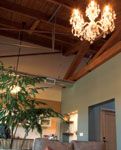10 ways to beautify your veterinary practice
You can accomplish a lot with a little investment. Here are some creative ways to spiff things up.
Dated. That's how the eye of a discerning consumer views your practice if it's been more than five years since you've changed your look. But why does it matter what your practice looks like? It's all about the medicine, right? You know the story. Clients can't judge your medicine, so they'll judge your appearance. Let's take a look at what pet owners might see when they visit your hospital—and what every practice can do to improve.

Stop and smell the flowers: Lush landscaping at Brown Trail Animal Hospital in Bedford, Texas, helps frame the front of the facility.
TAKE A CLOSER LOOK
Veterinary Economics Editorial Advisory Board member Dan Chapel, AIA, owner of Chapel Associates Architects in Little Rock, Ark., photographs every single wall in a practice and creates a slideshow for his clients. The dust, the clutter, the chipped paint, and the cracked tiles you don't notice during your daily stroll through the halls often pop when you're facing them on the computer screen.
Try it yourself: Walk through your practice with a camera and review any evidence of cobwebs and clutter. Then consider these 10 ways to beautify your practice:

A welcoming entry: A gravel path allows clients to walk through the garden in front of Brown Trail Animal Hospital in Bedford, Texas. The entry garden also has a patio, a fountain, and bench seating so visitors can enjoy the flowering plants and trees.
1. Tame wayward extension cords. You bought high-tech equipment to improve the quality of the medicine you practice and now that high-speed dental drill is leaning against the wall in surgery. Chapel says he sees extension cords everywhere: stapled down the wall, running across the counters because there aren't enough outlets. The treatment: Hire an electrician. You'll pay about $100 for each outlet you add. Considering that loose cords are a fire hazard and can be a threat to patients who see them as chew toys, this is a smart fix.
2. Tend to neglected landscaping. Your practice may be obscured by overgrown bushes, tree branches, and the very plants designed to make your facility more welcoming. Get in the thick of your thickets and trim out the overgrowth. Remove plants that are withered or sick-looking. Before you replace them, do your homework and talk to a landscape expert. Slower-growing plants that don't require much water are a good choice.

Let there be light: At Mt. Tabor Veterinary Care in Portland, Ore., pendant lights provide a controlled glow and the chandelier adds visual interest in the client waiting area. (Photos by Michael Sulis)
Kimberli Bragg, a partner with thoughtSPACE architecture firm in Lexington, Ky., suggests using plants and trees that change colors at different times of the year. Also, choose pet-friendly plants and avoid those that are common allergens. "Keep plants and trees a safe distance from the path to the entry, so that animal elimination doesn't kill them," Bragg says.
3. Rebuild the porch. If it's sagging, it's time. "You can rebuild it and put up new columns for not a lot of money," Chapel says. "It'll cost around $10,000 to $15,000 to tear the old one off and rebuild one with new columns."
4. Apply a fresh coat of paint. Painting your interior is cheap and easy, and it makes a world of difference, Bragg says. Don't be bashful about color, either. "No off-white. No beige. No mauve or country blue," Bragg says. "Paint most of the walls a crisp white or some definitive color that makes everything look clean. Then feature your reception desk or your corner store with a bold color."

Veterinary Economics Editorial Advisory Board member Mark Hafen, AIA, a senior partner with Animal Arts/Gates Hafen Cochrane in Boulder, Colo., says that painting can make a big impact on the outside of your hospital, too—as long as your colors send the right message.
Hafen recommends light colors that draw the eye in, like taupe. Then use brighter colors sparingly. Red, orange, blue, and green make great accent colors on chair rails or shutters. Awnings can also add pop to your curb appeal. "You can get backlit awnings and feature your logo," he says. "That's one of the neatest ways to add pizzazz to your building for a couple thousand dollars."
5. Replace windows that obscure, reflect, and distract. "Retail people learned a long time ago that you need to have clear glass windows," Hafen says. "There's a strong correlation between retail stores that fail and how dark their windows are." Your building will appear friendlier if you replace dark-tinted or reflective glass with clear glass.
6. Update waiting area seating. Don't stress yourself out looking for seating that's going to last forever. It won't—and you don't want it to. In five years, current colors and styles will look dated. Instead, Chapel says, look for sturdy chairs with a reasonable price tag—patio furniture often works well—and choose a variety of styles. For example, you might set up a few bistro-style tables and a bench or some loose chairs that clients can group around tables.
Chapel recommends dividing spaces into different seating areas. "I used to try to design a dog area and a cat area," Chapel says. "Well, that didn't work because people would come in with a dog and a cat. So now I create different seating areas so the client can choose. If you've got a real scared little dog, you can find a quiet area alone. Or if you want to be out there talking to people, you can be in the middle of everything. People can find their comfort zone."
7. Declutter countertops. "Less is more," Bragg says. Remove the fliers, cans, bottles, bags, and stacks of paper. You want your practice to look current, clean, calming, and professional. If you have merchandise in the waiting room, display it in a corner store—a destination that will make people want to go and check it out.
8. Use a mix of lighting. An ideal lighting scheme includes natural and incandescent lighting, says Tara Hill, an interior designer who works with human hospitals. And if you use fluorescent lighting, look for those on the warmer end of the spectrum.
Hill recommends using indirect lighting to create a pleasing and relaxing atmosphere. Accent lighting, such as track systems over the reception desk, are functional and add interest. "You can probably get a good start on a track system for about $500," Hafen says. Also, employee productivity improves when you increase the natural light of a work environment. "Say a skylight you installed for about $1,000 increases productivity 5 percent," Hafen says. "If the practice is grossing $500,000, you could increase your gross profit by $25,000."
9. Muffle noise. Installing fabric-wrapped panels on the walls to absorb sound will help, Hafen says. These can also add color and interest to your practice, and you can use them as bulletin boards. Check your doors as well. Cats and people startle when a door squawks or slams. A dose of lubricant or new weatherstripping will do wonders.
10. Nix dead plants. If the ferns are wilting, clients may wonder about your ability to keep their pets healthy. Plus, Bragg says, houseplants are homes for bugs and mold. Instead, consider fresh cut flowers twice a week on the reception desk.
IT REALLY WORKS
The money you spend on a remodel is an investment that can pay for itself many times over. Chapel gives this example: One of his clients recently undertook a substantial remodel that included tearing out landscaping, building a new sign and porch, changing the shape of the roof, painting the building, laying new asphalt, and re-striping the parking lot. "It was like we'd built a new building," Chapel says. "People who'd lived in that community for 10 years came in to say, 'Gosh, I can't believe you put an animal hospital here.'"
The kicker? The clinic had been at that location since 1950. For an $80,000 investment, the practice owner saw a 30 percent increase in business, which Chapel says is common after a remodel. "It more than pays for itself," he says.
Portia Stewart is the former editor of Firstline and a freelance writer in Lenexa, Kan. Please send questions or comments to ve@advanstar.com
Editors' note: Find more tips to inexpensively freshen up your veterinary practice at dvm360.com. Search "easy practice makeovers."